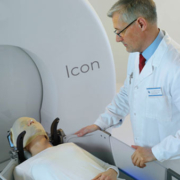The use of gamma knife surgery as a means of tackling brain metastases has been established for many years, but alongside this is a growing understanding of how to measure the success of operations when they are carried out.
Of course, it can be easy enough to establish what the outcome is in time after an operation, but surgeons and patients alike can be helped greatly when predictive technology can give them a prior guide as to the effects of any procedure.
Just such a piece of predictive technology has been developed in China, where a team from the Hefei Institutes of Physical Science of Chinese Academy of Sciences has devised a radiomic model for predicting how patients will respond to radiotherapy treatment in brain metastases.
Their findings, published in European Radiology, were based on the data that radiomic features in MRI images can provide about the biology of tumours.
These elements, which are not detectable by normal methods of image interpretation, can then provide bodies of data that can be accessed by machine learning methods to predict the responses of different tumours according to their radiomic profiles.
If this method proves to be successful, it will further enhance the value of radiotherapy, by providing a basis for understanding the likely outcome of any single operation and thus enabling specialists to plan treatments accordingly.
For instance, if one operation is predicted to have limited success and a second is likely to be required, this can be planned for, while in other cases a single operation may be seen as likely to achieve the aim in one go.
As the first author of the paper Wang Yixin explained, a key benefit of this approach is to avoid the ‘black box’ element of machine learning algorithms, which can only use previous data. In this instance, the machine learning makes use of game theory based on Shapley Additive Explanations (SHAP), which the team established was useful for formulating the precise treatments needed.
If the method proves to be successful, it will for the first time provide an accurate system for predicting the effects of radiotherapy, making what is already an effective method of treatment that can save lives into something even more powerful.
The news emerges at a time when alternative means of treating brain metastases are still in the early development stage.
For instance, in the US researchers at the University of Alabama have just hailed some very promising results in stage 1 trials for a new glioblastoma multiforme treatment called INB-200, with all of the patients in the trial living longer than expected.
The results, presented at this month’s American Society of Clinical Oncology Annual Meeting, revealed how the therapy, using Gamma Delta T-cells that can help distinguish between healthy and diseased tissue, has proved effective thus far.
However, as this is just stage 1 of the trials, the treatment is some way off the point where it might be used to treat patients around the world.
While such developments can add to the armoury of oncologists in the battle against brain cancer, radiotherapy remains the swiftest, most effective weapon. More accurate projections of outcomes could make this even more powerful in the future.












